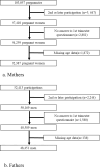Sick building syndrome, multiple chemical sensitivity, and related factors: A cross-sectional analysis from the Japan Environment and Children's Study
- PMID: 40465554
- PMCID: PMC12136361
- DOI: 10.1371/journal.pone.0324562
Sick building syndrome, multiple chemical sensitivity, and related factors: A cross-sectional analysis from the Japan Environment and Children's Study
Abstract
Sick building syndrome (SBS) is caused by having unhealthy indoor environments. Multiple chemical sensitivity (MCS) is a chronic condition that is potentially triggered by low-level chemical exposure. Demographic factors, lifestyle factors, and comorbidities have been reported as potential risk factors of both conditions; however, studies on these factors involving large populations in Japan are limited. The aim of this study was to investigate whether demographics, lifestyle, and comorbidities were associated with MCS and SBS in a large Japanese population, and whether autistic traits (Japanese version of the Autism-Spectrum Quotient Short Form, AQ-10-J), psychological distress (Japanese version of the Kessler 6-Item Psychological Distress Scale, K6), and serum total and allergen-specific immunoglobulin E (IgE) levels were related to the outcomes. The participants included 92,387 pregnant women and 48,451 partners. The outcomes were self-reported physician-diagnosed SBS, MCS, and SBS and/or MCS (combined outcome [CO]). Age-adjusted odds ratios (ORs) of total and antigen-specific IgE levels, demographic factors, and lifestyle factors were determined. The proportions of pregnant women with SBS, MCS, and CO were 307 (0.33%), 128 (0.14%), and 415 (0.45%), respectively, while those of their partners were 85 (0.18%), 30 (0.06%), and 112 (0.23%), respectively. Allergic diseases, psychiatric diseases, migraine, and higher psychological distress were associated with significantly higher ORs for SBS, MCS, and CO. Among pregnant women, autoimmune diseases, cancer, kidney diseases, higher physical activity, autistic traits, and total and specific IgE levels were associated with significantly higher ORs for SBS, MCS, and CO. Clinicians should consider common comorbid disorders when treating patients with SBS and MCS, and their protective and deteriorating lifestyles and demographic factors should be clarified.
Copyright: © 2025 Saijo et al. This is an open access article distributed under the terms of the Creative Commons Attribution License, which permits unrestricted use, distribution, and reproduction in any medium, provided the original author and source are credited.
Conflict of interest statement
The authors have declared that no competing interests exist.
Similar articles
-
Lifestyle behaviors and home and school environment in association with sick building syndrome among elementary school children: a cross-sectional study.Environ Health Prev Med. 2020 Jul 11;25(1):28. doi: 10.1186/s12199-020-00869-2. Environ Health Prev Med. 2020. PMID: 32652952 Free PMC article.
-
[Risk factor for lifestyle and way of living for symptoms of sick building syndrome: epidemiological survey in Japan].Nihon Eiseigaku Zasshi. 2009 May;64(3):689-98. doi: 10.1265/jjh.64.689. Nihon Eiseigaku Zasshi. 2009. PMID: 19502765 Review. Japanese.
-
Environmental tobacco smoke exposure and overtime work as risk factors for sick building syndrome in Japan.Am J Epidemiol. 2001 Nov 1;154(9):803-8. doi: 10.1093/aje/154.9.803. Am J Epidemiol. 2001. PMID: 11682362
-
Associations between indoor environment and lifestyles and sick building syndrome symptoms among adults in Taiyuan and Urumqi of China.Indoor Air. 2022 Jul;32(7):e13081. doi: 10.1111/ina.13081. Indoor Air. 2022. PMID: 35904392
-
Folic acid supplementation and malaria susceptibility and severity among people taking antifolate antimalarial drugs in endemic areas.Cochrane Database Syst Rev. 2022 Feb 1;2(2022):CD014217. doi: 10.1002/14651858.CD014217. Cochrane Database Syst Rev. 2022. PMID: 36321557 Free PMC article.
References
-
- Ghaffarianhoseini A, AlWaer H, Omrany H, Ghaffarianhoseini A, Alalouch C, Clements-Croome D, et al.. Sick building syndrome: are we doing enough?. Archit Sci Rev. 2018;61(3):99–121. doi: 10.1080/00038628.2018.1461060 - DOI
-
- Kishi R, Araki A. Importance of Indoor Environmental Quality on Human Health toward Achievement of the SDGs. In: Kishi R, Norbäck D, Araki A, editors. Indoor Environmental Quality and Health Risk toward Healthier Environment for All. Singapore: Springer Singapore; 2020. p. 3–18.
-
- Saijo Y. Sick Building/House Syndrome. In: Kishi R, Norbäck D, Araki A, editors. Indoor Environmental Quality and Health Risk toward Healthier Environment for All. Singapore: Springer Singapore; 2020. p. 21–38.
MeSH terms
Substances
LinkOut - more resources
Full Text Sources


